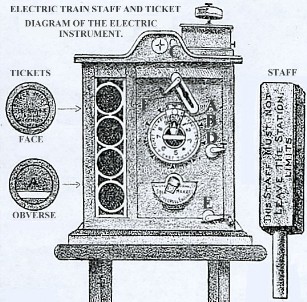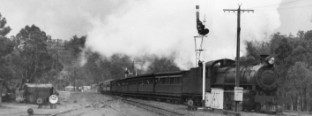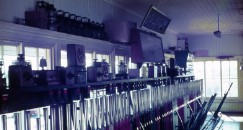Electric Train Staff and Ticket
Block Working in WA
SINGLE LINE WORKING
ELECTRIC STAFF AND TICKET
ELECTRIC STAFF AND TICKET
WHEN WAS IT USED?
The Electric Staff and Ticket Working method of working was described in the Western Australian Railways Appendix to Working Time-Book No. 2, of the 15th April, 1896. This is a System of facilitating the working of Single Line. It provides for the Train-Ticket always being obtainable at either end of a section when required (provided there is no Train already in the Section), and supersedes the ordinary Staff and Ticket System.

An Electric Train-Staff and Ticket Apparatus (called a staff instrument) is fixed at each end of a Staff Section, containing a number of Train Tickets, only one of which can be taken from the column at one time, and only one can be out of both Instruments at one time, so that when one Train-Ticket has been taken out at Station Y another cannot be taken out at Station Z, nor can another be taken out from Station Y until the one previously taken out has been either put back in the Instrument from which it was first taken or put in the Instrument at the other end of the Section.
ILLUSTRATION OF WORKING TRAIN STAFF APPARATUS.
The Ticket Indicator (A) in the centre of the instrument must, in its normal position, point to the word "Staff."
The Ticket Indicator or Cross Handle Pointer (B) underneath the Train Indicator must, in its nominal position, point to word "Staff."
The nominal position of the galvanometer needle (C) will be vertical.
The Tapper Key (D) serves to transmit all signals on the Bell as Code.
Let Y and Z represent two Staff Stations - one at either end of a Staff Section.
Y has a train ready to enter the Section and proceed towards Z.
Y calls Z on the Key (D), by giving the "Warning" Signal according to the description of the Train.
Z replies by repeating the Signal.
Y then gives the "Train-Staff" Signal (5 Beats).
Z acknowledges by 5 Beats, and keeps the key depressed on the 5th Beat, holding it in that position (which electrically unlocks the instrument at Station Y, and deflects the galvanometer needle to the right in both instruments), and keeping his eye on the galvanometer needle.
Y, after receiving the acknowledgement (5 Beats), turns his Staff round to the left and withdraws it, and at once depresses the Tapper Key (D) half-way, when the needle resumes vertical position, which will indicate that Staff is withdrawn. On receipt of this signal, Z releases his Key and turns the cross handle points to ticket 1, and presses sown the key again, causing the Galvanometer Needle to be deflected as soon as the needle is deflected, Y puts a ticket in drum and withdraws same by lifting handle quickly, which throws the ticket out below, then depresses the Key until the needle resumes vertical position - which will indicate "Ticket" is out. He (Y) then turns Train indicator to "Ticket."
Y will then give the Ticket to the Engine-driver of the waiting Train showing him Staff at same time, and thus authorise him to enter the section of the line, and on the departure of the train immediately gives the "Departure" Signal (2 Beats) to Z, replacing Staff in Instrument, and turning it to the right, then giving the "Departure" Signal (2 Beats) to Z.
Z acknowledges by 2 Beats.
The instrument at each end of the Section being interlocked, no second Ticket can by any means be issued at either end of the Section.
Upon the train arriving at Z, the Engine-driver gives the Train Ticket to the Officer in charge, who inserts it into the Ticket Entrance, throws it into the instrument by lifting handle F quickly, which operation will turn cross handle pointed back to its normal position, then gives the "Arrival" signal (3 beats) to Y.
Y acknowledges by 3 Beats, and at once turns his Train Indicator to "Staff."
The Officer in charge at either end of the Section is then in a position to issue a Train Ticket.
Thus it can be readily understood that consecutive Trains can follow one another from the same Station into the same section as soon as the preceding Train Ticket has arrived at and been inserted into the Instrument at the Station in advance, thereby enabling another Ticket to be obtained at the Station in the rear for the following Train.
Under no circumstances (except in the case of a disabled Train or Engine, see Regulations 10 and 11 in Appendix) must a Train Ticket be transferred from one Train to another without being passed through the Staff Instrument and dealt with in the regular way.
Page 12, of Weekly Notice 5 of 1896 carried the following entry regarding the use of these instruments:
Regulations for Working the Train Staff and Ticket Apparatus.
_____
Several failures have recently occurred through faulty manipulation of the Electrical Staff and Ticket Instruments, and special care must be exercised by the Staff to see that all the Signals are given in a clear and careful manner, and that the illustration shown on page 115 of Appendix is strictly carried out. Care should particularly be given to see that Tickets are not left on the shelf, as by this means the instrument becomes jammed.
Operators must insist on all imperfect signals being repeated.
COMMENCING FROM MONDAY, 28th INSTANT.
An additional Signal (five rings - 1-3-1) will be added to the Bell Code, and will signify "staff withdrawn, release ticket."
Paragraph 11 contained in the instructions illustrating working of the instrument on page 115 of the Appendix is hereby superseded, and the following will come into operation at 12 a.m. on 28th instant:-
Y after receiving the acknowledgement (five beats) turns his staff round to the left and withdraws it, and at once depresses the tapper key (D) halfway, which will throw the needle back to zero. If the staff has been properly withdrawn Y will give the "staff withdrawn, release ticket," Signal (1-3-1) which will be an indication to the operator at Z that the Staff is out of the instrument. On receipt of this signal Z turns the cross-handle pointer to ticket 1 and repeats the signal (1-3-1), holding down on last beat, causing the galvanometer needle to be deflected. As soon as the needle is deflected Y puts a ticket in drum and withdraws same by lifting handle quickly, which throws the ticket out below, then depresses the key until the needle resumes vertical position - which will indicate "ticket" is out. He (Y) then turns Train indicator to "ticket."
Station-masters will be held responsible for seeing that the appendices in the hands of the Staff at their stations are corrected in accordance with the above instructions, and that the staff thoroughly understand them.


